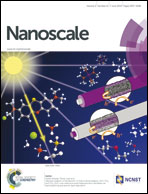Microsystem-assisted synthesis of carbon dots with fluorescent and colorimetric properties for pH detection
Abstract
The present paper describes the use of a microfluidic system to synthesize carbon dots (Cdots) and their use as optical pH sensors. The synthesis is based on the thermal decomposition of ascorbic acid in dimethyl sulfoxide. The proposed microsystem is composed of a fluidic and a thermal platform, which enable proper control of synthesis variables. Uniform and monodispersed 3.3 nm-sized Cdots have been synthesized, the optical characterization of which showed their down/upconversion luminescence and colorimetric properties. The obtained Cdots have been used for pH detection with down and upconverison fluorescent properties as excitation sources. The naked eye or a photographic digital camera has also been implemented as detection systems with the hue parameter showing a linear pH range from 3.5 to 10.2. On the other hand, experiments on the cytotoxicity and permeability of the Cdots on human embryonic kidney cells revealed their adsorption on cells without causing any impact on the cellular morphology.


 Please wait while we load your content...
Please wait while we load your content...